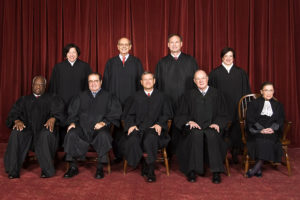Oct
23
“[A]ll federal court judges, but most particularly Supreme Court justices, exert substantial influence on the development and application of the law over a long period, often for decades after the president who appointed them has left office…. The stakes are high indeed.” — John G. Malcolm, director of the Heritage Foundation’s Edwin Meese III Center for Legal and Judicial Studies
If you read my previous post about (reluctantly) voting for Trump, you may have noticed that I didn’t mention the Supreme Court nominations that the next president will probably have to make. It’s not that they aren’t important — they absolutely are! But, I tried to talk only about the issues themselves, many of which will, of course, be addressed in federal court cases and, in some cases, before SCOTUS.
As we all know, with Justice Antonin Scalia’s untimely death — which some believe to have been under suspicious circumstances — back in February, the Supreme Court is still awaiting a replacement for that 9th position. It looks like that won’t happen until the next POTUS is sworn in. But, given the advanced ages of half of the currently sitting justices, it is likely that three or four more will need to be replaced over the next 4-8 years.
I shudder to think of the Left-leaning, activist justices that a President Hillary Clinton would appoint. Republicans in Congress would not be able to reject all her nominations, and it’s highly doubtful that she would nominate an actual originalist/conservative. At best, we would get a few centrists in the mold of Justice Anthony Kennedy, the Court’s current moderate and unpredictable swing-vote. As “fair” as this might sound, it would probably be a disaster. However, a President Donald Trump would appoint more Right-leaning justices. In fact, Trump has already provided 21 names of people that he and his team have preliminarily vetted for nomination.
In an article published a few weeks ago, The Heritage Foundation’s John G. Malcolm gave a brief analysis of Trump’s picks. First, though, here’s the list in two parts. (The first group was announced here and the second here.):
Steven Colloton
Allison Eid
Raymond Gruender
Thomas Hardiman
Raymond Kethledge
Joan Larsen
Thomas Lee
William Pryor
David Stras
Diane Sykes
Don Willett
Keith Blackwell
Charles Canady
Neil Gorsuch
Sen. Mike Lee
Edward Mansfield
Frederico Moreno
Margaret Ryan
Amul Thapar
Timothy Tymkovich
Robert Young
Malcolm says that they all “appear to be eminently qualified”. Many held distinguished clerkships, including nine for Supreme Court justices. Many teach or have taught law at prestigious law schools. Several served as state or federal prosecutors and at least one as a federal public defender. One (M. Lee), of course, is currently a U.S. Senator, while another (Canady) is a former, four-term U.S. Representative.
With nine on the list being sitting state supreme court justices from eight different states across the country, Malcolm notes that Trump’s potential nominees represent a much better “cross-section of America” than the current Supreme Court line-up. Beyond geographical diversity, what is the advantage of this?
“Individuals with experience on state courts are less likely to have a jaundiced view of the competency of state court judges…. They are also more likely to pay greater heed to issues involving federalism, which also tends to get short shrift by federal legislators and judges.”
Even more important, Malcolm believes that everyone on the list appears to hold the position that…
“… a judge should interpret the text and structure of a statute or the Constitution, based on the original public meaning of that text at the time it was adopted, and should not, under the guise of statutory or constitutional interpretation, impose on the rest of society his or her own policy predilections based on that judge’s perceptions of contemporary mores.”
Excellent!
Some have been worried about who Trump would appoint to the Supreme Court, especially since he told Mark Halperin last August that he thought his sister Maryanne Trump Barry, a very liberal and strongly pro-choice federal judge, would make a “phenomenal” justice. Thankfully, she seems to be off the (official) list. Not only would that smell of nepotism, it would be terrible news for the pro-life movement. I, for one, am very encouraged by this list of originalist, constitutionalist candidates — not just for pro-life cases but for the many defining issues that will be addressed in the near future, and for the integrity of the Court and the federal judicial system.
















